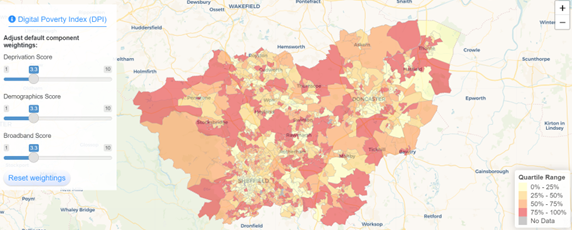Researchers at the University of Sheffield used several CDRC datasets as part of their research into digital poverty in South Yorkshire. The South Yorkshire Mayoral Combined Authority (SYMCA) wanted a better understanding of how digital poverty and digital exclusion play a role in the region, and how to build digital capability in the region, particularly for social groups identified as at risk.
The research team mapped digital poverty in the South Yorkshire region. This allowed them to assess the areas at greater risk of digital poverty, by highlighting the intersections of different inequalities and barriers that different social groups in the region experience. This provided a place-based nuanced understanding of which populations and areas are more affected and thus potentially excluded from the labour market, education, and services due to being digitally excluded.

The findings are helping SYMCA create a positive impact in the region: they will inform the region’s COVID-19 recovery plan and the agenda for implementing their Inclusion Plan and is providing feasible and research- and evidence-informed pathways towards alleviating digital exclusion and digital poverty. Besides supporting the most disadvantaged citizens, by leveraging the findings of this project, SYMCA will be better able and prepared to create further digital development opportunities in the region, e.g., by supporting the development of literacies, entrepreneurship, and talent- thus supporting its economic recovery.
For more information see the project webpage: https://www.sheffield.ac.uk/office-for-data-analytics/digital-poverty
The visualisation tool is available here: https://sheffield-university.shinyapps.io/Digital-Poverty/
The project was funded through the Knowledge Exchange Support Fund (QR Policy and Covid Recovery) and supported by the South Yorkshire Office for Data Analytics Pilot.


